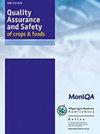近红外光谱在不同畜群之间分离奶牛原料奶的功效,用于产品创新和可追溯性
IF 5.3
3区 农林科学
Q1 FOOD SCIENCE & TECHNOLOGY
引用次数: 1
摘要
具有特殊特征和需求的奶牛可以聚集到不同的畜群中进行有针对性的营养管理,并促进农场原料奶的分离,以生产高价值的利基乳制品,从而提高经济回报。需要快速独立验证产品质量和原产地的方法,以支持此类产品的验证和可追溯性。本研究利用近红外光谱(NIRS)对饲喂相同或不同饲养制度的不同畜群的多个品种的单个奶牛进行原料奶分离,并对每个畜群的粗蛋白质和乳脂肪酸(FA)表型预测的有效性进行关联和评估。从新西兰林肯大学奶牛场3个品种的847头泌乳奶牛中采集代表性冻干原料乳样品(n = 220),获得参考值和近红外光谱。饲料来源(即牧草或苜蓿青贮牧草)对蛋白质和FA值有显著影响,这些差异在近红外光谱分析中得到反映。偏最小二乘回归模型对粗蛋白质的测定结果很好,而对最主要FA的测定结果不明显。采用偏最小二乘判别分析,在相同饲养条件下的畜群之间获得了最大的分离度(平均特异性为95.2%),其区分对象的总体性能优于类类比的软独立建模。本研究中进行的多类别分析改进了目前用于特定乳制品生产的原料奶的评估和验证方法,并增强了产品的可追溯性。本文章由计算机程序翻译,如有差异,请以英文原文为准。
Efficacy of near infrared spectroscopy to segregate raw milk from individual cows between herds for product innovation and traceability
Cows with specialised characteristics and requirements can be aggregated into different herds for targeted nutritional management and to facilitate on-farm segregation of raw milk for the production of high-value niche dairy products, offering improved economic returns. Rapid methods for independent verification of product quality and origin are desirable to support validation and traceability of such products. This study examined the use of near infrared spectroscopy (NIRS) to segregate raw milk from individual cows of multiple breeds from different herds fed on the same or differing feeding regimes, and to correlate and evaluate the efficacy of the predictions for crude protein and the milk fatty acid (FA) phenotypes for each of the herds. Reference values and near infrared spectra were obtained from representative freeze-dried raw milk samples (n = 220) collected from 847 lactating cows of 3 breeds from the Lincoln University dairy farm in New Zealand. The feed sources (i.e. pasture or pasture with lucerne silage) significantly influenced the protein and the FA values, and these differences were reflected in NIRS analyses. The partial least square regression models for crude protein determination showed excellent results, whereas for the most dominant FA, they were not appreciable. Maximum separation was obtained between the herds on the same feeding regime (mean specificity = 95.2%) using the partial least square discriminant analysis, and its overall performance in differentiating the objects was better than that of the soft independent modelling of class analogy. The multiclass analyses conducted in this study offer improvements to current approaches for evaluating and validating raw milk for the manufacture of specific dairy products, and for enhancing product traceability.
求助全文
通过发布文献求助,成功后即可免费获取论文全文。
去求助
来源期刊

Quality Assurance and Safety of Crops & Foods
FOOD SCIENCE & TECHNOLOGY-
CiteScore
4.60
自引率
7.50%
发文量
61
审稿时长
1 months
期刊介绍:
''Quality Assurance and Safety of Crops & Foods'' is an international peer-reviewed journal publishing research and review papers associated with the quality and safety of food and food sources including cereals, grains, oilseeds, fruits, root crops and animal sources. It targets both primary materials and their conversion to human foods. There is a strong focus on the development and application of new analytical tools and their potential for quality assessment, assurance, control and safety. The scope includes issues of risk assessment, traceability, authenticity, food security and socio-economic impacts. Manuscripts presenting novel data and information that are likely to significantly contribute to scientific knowledge in areas of food quality and safety will be considered.
''Quality Assurance and Safety of Crops & Foods'' provides a forum for all those working in the specialist field of food quality and safety to report on the progress and outcomes of their research.
 求助内容:
求助内容: 应助结果提醒方式:
应助结果提醒方式:


